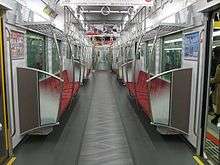Nishitetsu 9000 series
| Nishitetsu 9000 series | |
|---|---|
|
3-car set 9002 undergoing testing in February 2017 | |
| Manufacturer | Kawasaki Heavy Industries |
| Replaced | 5000 series |
| Constructed | 2016– |
| Entered service | 20 March 2017 |
| Number under construction | 13 vehicles (5 sets) |
| Number built | 5 vehicles (2 sets) |
| Number in service | 5 vehicles (2 sets) |
| Formation | 2/3 cars per trainset |
| Operator(s) | Nishi-Nippon Railroad |
| Line(s) served | Nishitetsu Tenjin Ōmuta Line |
| Specifications | |
| Car body construction | Stainless steel |
| Car length | 19,500 mm (64 ft 0 in) |
| Width | 2,760 mm (9 ft 1 in) |
| Height | 4,165 mm (13 ft 8.0 in) |
| Floor height | 1,180 mm (3 ft 10 in) |
| Doors | 3 pairs per side |
| Maximum speed |
|
| Traction system | Variable frequency (IGBT) |
| Acceleration | 2.5 km/h/s |
| Deceleration |
3.5 km/h/s (service brake) 4.0 km/h/s (emergency brake) |
| Power supply | 1,500 V DC |
| Current collection method | Overhead catenary |
| Track gauge | 1,435 mm (4 ft 8 1⁄2 in) |
The Nishitetsu 9000 series (西鉄9000形) is an electric multiple unit (EMU) train type operated by the private railway operator Nishi-Nippon Railroad (Nishitetsu) in Japan on the Nishitetsu Tenjin Ōmuta Line since 20 March 2017.
Design
The 9000 series trains were built by Kawasaki Heavy Industries in Kobe, with two three-car sets and two two-car sets (10 vehicles) entering service in March 2017, and a further two three-car sets and one two-car set (eight vehicles) entering service in May 2017.[1][2]
Based on the earlier 3000 series trains, externally, the new trains carry a livery with a "royal red" waist-line stripe.[1]
Operations
The 9000 series trains operate on Nishitetsu Tenjin Ōmuta Line express and all-stations local services.
Formations
2-car sets
The two-car sets are formed as follows with one motored ("M") car and one non-powered trailer ("T") car.[3]
| Designation | M | Tc |
|---|---|---|
| Numbering | 91xx | 95xx |
| Weight (t) | 36.3 | 27.2 |
| Capacity (Seated/total) | 40/124 | 40/124 |
The motored car has two single-arm pantographs.[3]
3-car sets
The three-car sets are formed as follows with one motored ("M") car and two non-powered trailer ("T") cars.[3]
| Designation | Tc | M | Tc |
|---|---|---|---|
| Numbering | 90xx | 93xx | 95xx |
| Weight (t) | 26.0 | 34.6 | 27.2 |
| Capacity (Seated/total) | 40/124 | 38/138 | 40/124 |
The motored car has two single-arm pantographs.[3]
Interior

Passenger accommodation consists of longitudinal bench seating with a seat width of 470 mm (19 in) per person.[4] LED lighting is used in the interiors, and two 17-inch LCD passenger information screens are provided above each of the doorways with information provided in four different languages (Japanese, English, Korean, and Chinese).[1]
History
Details of the new trains were officially announced in February 2016.[1] The first two trains (one three-car and one two-car set) entered revenue service on 20 March 2017.[5]
References
- 1 2 3 4 西日本鉄道、天神大牟田線に新型車両「9000形」デビューへ [Nishi-Nippon Railroad to introduce new 9000 series on Tenjin Ōmuta Line] (in Japanese). Japan: Tetsudo Shimbun. 4 February 2016. Archived from the original on 10 September 2016. Retrieved 21 March 2017.
- ↑ 西鉄、新型車両「9000形」導入 来年3月、軽量化や省エネ図る [Nishitetsu to introduce new 9000 series next March with light weight and energy savings]. Sankei News (in Japanese). Japan: Sankei Shimbun & Sankei Digital. 5 February 2016. Archived from the original on 5 February 2016. Retrieved 21 March 2017.
- 1 2 3 4 Sugiyama, Akihisa (June 2017). 西日本鉄道 9000形 [Nishi-Nippon Railroad 9000 series]. Japan Railfan Magazine (in Japanese). Vol. 57 no. 674. Japan: Koyusha Co., Ltd. p. 85-89.
- ↑ 西日本鉄道 9000形 [Nishi-Nippon Railroad 9000 series]. Japan Railfan Magazine (in Japanese). Vol. 56 no. 660. Japan: Koyusha Co., Ltd. April 2016. p. 65.
- ↑ 西鉄9000形が営業運転を開始 [Nishitetsu 9000 series enters revenue service]. Japan Railfan Magazine Online (in Japanese). Japan: Koyusha Co., Ltd. 21 March 2017. Archived from the original on 21 March 2017. Retrieved 21 March 2017.
External links
| Wikimedia Commons has media related to Nishitetsu 9000 series. |
- Nishitetsu 9000 series information (in Japanese)
- Kawasaki Heavy Industries news release (in Japanese)
